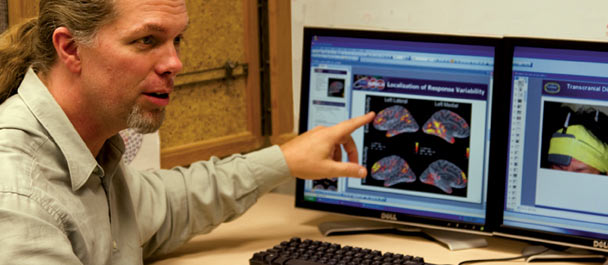
Scientific Lectures //
A MRI study of Sustained Neuromodulation Induced by Electrical Tongue Stimulation in Balance Disorde
Elizabeth Meyerand, Ph.D. - Department Chair of Biomedical Engineering, University of Wisconsin
Presented: November 14, 2013
ABSTRACT: Neurostimulation has emerged as a promising approach to precisely target and modify activity within neuronal structures. The flexibility of this technique has made it a common tool for research into normal brain function and as a potential therapy for many neurological disorders. Electrical stimulation through the tongue offers multiple advantages over other routes of administration including access to the central nervous system without invasive surgeries, the ability to stimulate using low voltages (< 12 V), high receptor density allowing high data throughput, and a very compact stimulation device liberated from accessory equipment and the need for a permanent power source. Recent studies suggest that stimulation through the tongue can produce sustained behavioral and subjective improvements in individuals with chronic balance disorders, even when the stimulation device has been removed. In this thesis, postural sway and physical therapy measures were used to show that information-free stimulation through the tongue, termed cranial nerve non-invasive neuromoduation (CN-NINM), could indeed produce sustained improvements in the functional deficits and subjective symptoms in subjects with balance disorders. Subsequently, we applied advanced analysis techniques to functional magnetic resonance imaging (fMRI) data in order to investigate balance-processing dysfunction in these individuals compared to healthy controls. Results suggest that balance-impaired individuals have visual motion-dependent hypersensitivity of the entire balance-processing network, extending previous findings that this hypersensitivity was limited to the visual cortices. We then compared network processing before and after individuals with balance disorders received information-free tongue stimulation. We found that CN-NINM normalizes the network response to visual-motion and likely induces sustained neuromodulation of the trigeminal nuclei of the brainstem – the site at which the incoming stimulation enters the central nervous system. Collectively, the work provides a preliminary understanding of how electrical tongue stimulation modulates the balance-processing network to produce long-term behavioral improvements in individuals with balance disorders.
BIOGRAPHY: Professor Beth Meyerand graduated from the Medical College of Wisconsin in 1996 with a PhD in Biophysics. She completed a Postdoc at Dartmouth, and joined the faculty at the University of Wisconsin in 1998. Professor Meyerand is currently the Chair of the Department of Biomedical Engineering at the University of Wisconsin. She also holds the Vilas Distinguished Achievement Professorship at the university level, and holds a joint appointment in the Department of Medical Physics. She is Co-Director of a NIH sponsored T32 graduate training program in clinical neuroengineering, and she serves as director of Wisconsin’s pre-clinical MRI facility. Professor Meyerand’s research is focused on developing novel MRI methods for brain imaging in various patient populations. She has published more than 70 peer-reviewed journal articles and serves as an associate editor for Medical Physics and Brain Imaging and Behavior.
Information shared in this lecture was requested be held from public access. MRN employees can access the presentation here.

